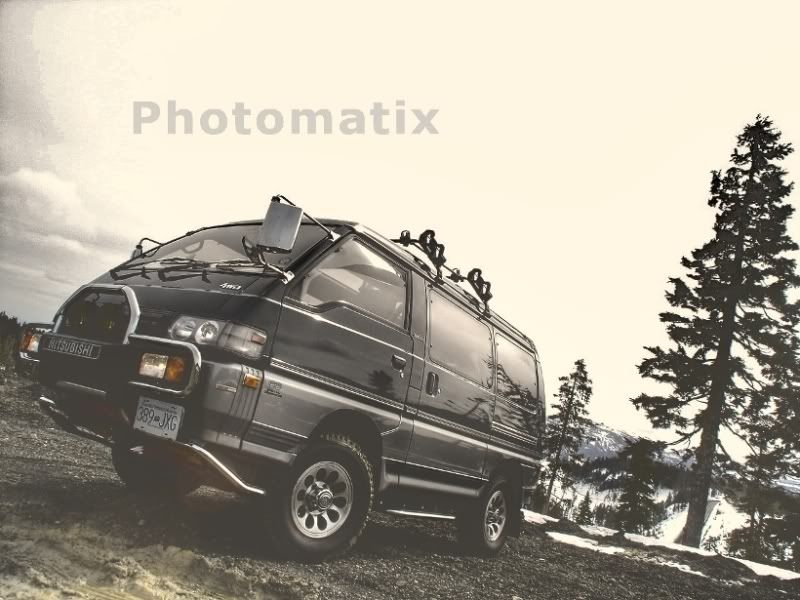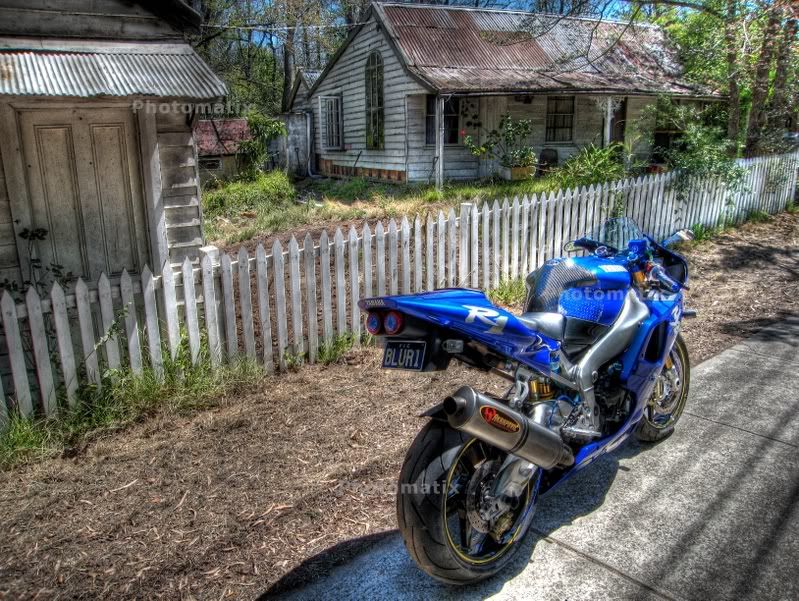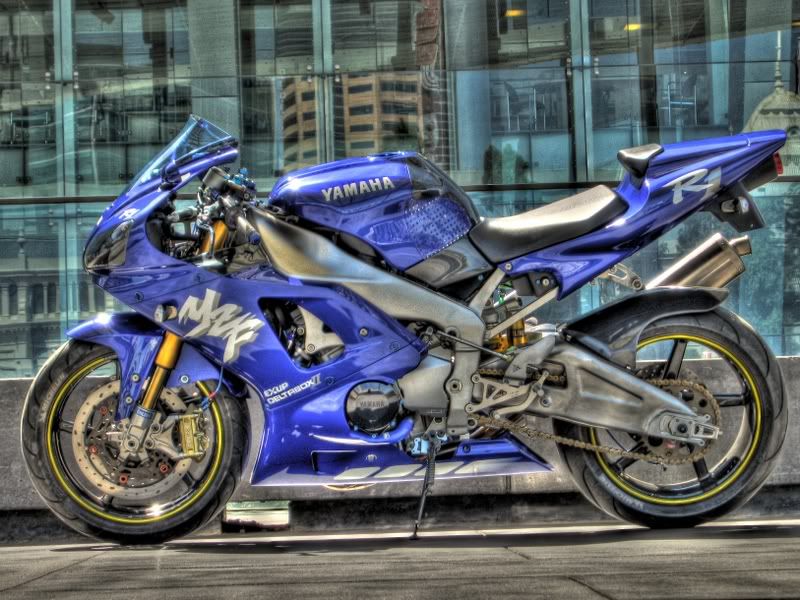Page 1 of 1
HRD Photomatix
Posted: Mon Mar 10, 2008 7:37 pm
by Fanny Bay Delica
Guys,
I belong to another Yamaha forum for R1 crotch rockets and all the rage is this HRD photomatix shooting/adjusting of photos. They look amazing and the software is available by googling it. You just take three photos of the exact same shot while adjusting the brightness and the software combines the pics into some amazing photos. I didn't have three shots of the same thing so I just varied the brightness and contrast on one of the photos Bruce took of rig and tried it.
Now this is not a good example of what cane be done but the motorcycle photos I've seen when this is done properly are unbelievable (if you think Delica guys are fanatical you should see how obsessed these guys are


)
Anyway what do you think??

Re: HRD Photomatix
Posted: Mon Mar 10, 2008 11:25 pm
by Kuan
Hi Andy,
Its actually called HDR not HRD. It stands for high dynamic range. Basically you expose for the highlights in one, midtones in the second, and shadows in the third for example. This will give you an image with everything exposed "correctly" with a large dynamic range.
Typically, the camera has to determine the exposure by evaluating the light and dark areas it sees. However, if you have a bright sky, and dark area such as shadows its difficult for the camera to expose all correctly because of its limited dynamic range. You either get a blown out sky or shadow areas that are black.
If you want to try and make these photos in photomatix. Set up your camera (dslr preferably) on a tripod. Shoot one where the sky is exposed properly, shoot one where the shadows are exposed well but the sky is blown out, and shoot a third somewhere in between. This is easy to do on a dslr with manual controls and RAW format. I don't know about point and shoots. Then you can combine them in that program which will select the right tones for each area.
If I make it to one of these meets, I'll bring my gear and we can shoot some Delica nasty - maybe do a 2009 calendar??
Re: HRD Photomatix
Posted: Tue Mar 11, 2008 4:49 am
by Mystery Machine
Hi Andy,
Have you got any links to some of these images? Not too hot on bikes myself, but interested to see more results of this HDR stuff...
Kuan - I don't have a DSLR (or anywhere near the skill to weild one!) but might have a go with my 'point & squirt' just to see how it comes out (there are some manual settings on my camera, so might be a good chance to try them out...)
Re: HRD Photomatix
Posted: Tue Mar 11, 2008 7:03 am
by jaggedfish
Andy, Andy, Andy.... HRD = Honda Racing Developments

... Does this mean you are subconsciously and Honda Dude instead of Yammy?

Good tip on the software tho... will have to check it out. Just wanted to get a little biker to biker dig in there....

Cheers, Ian
Re: HRD Photomatix
Posted: Tue Mar 11, 2008 7:59 am
by DelicaMark
You could also acheive this affect using a layering technique in Photoshop or any other photo editing program that allows for layers. You could take one photo of something and create three layers with the same photo. Each layer would then get processed differently and then combined all together. Like what Kaun described with the three photos, instead just use one photo three times with three different affects and combine the results.
This would work for the point and shooters out there...and for that matter it would work well for the DSLR shooters out there too

Either way it looks like a cool idea and has given me some ideas...
-Mark
Re: HRD Photomatix
Posted: Tue Mar 11, 2008 9:00 am
by Fanny Bay Delica
Re: HRD Photomatix
Posted: Tue Mar 11, 2008 9:24 am
by Kuan
To be honest, I'm not a huge fan of HDR and I think it doesn't work well for vehicle portraits.
I think what you want to do for your vehicle is bring the viewers attention to it and not the background. You can acheive this in a number of ways, either through lighting, selective focus, perspective etc.
HDR just puts everything at the same level for attention making for a lack of sense of centre piece. If you look at some good car nasty you will notice this I think. I think HDR is good for landscapes.
Anyway, just my opinion and its always fun to mess around and share the results.
Re: HRD Photomatix
Posted: Tue Mar 11, 2008 9:49 am
by jwfchase
Bruce, if all your photos have been from a "point-and-squirt" I can't imagine the pics you'd take with a DSLR, you seem to have an eye for photography! (Based on some of the pictures you've posted up here- and no I don't mean the tech ones, though they're great too!)
Re: HRD Photomatix
Posted: Tue Mar 11, 2008 10:09 am
by trialsmaster2
I dabble in HDR images sometimes too. I do all my shooting now with a Nikon D80 now, but my fiance has had similar results using her Sony W90 point and shoot. Just make sure you use a tripod if you have one, so all three shots line up perfectly. With HDR, you can make them as artsy or subtle as you want.
Here is an HDR picture (3 images combined in this one) of my F350 (which is for sale, by the way) while doing some forestry roads exploration. This was a fairly high contrast scene, so I think it worked out well...

You can see some more examples of the HDR stuff that I've taken in my picasa galleries here:
http://picasaweb.google.com/isaaron/Off ... nAndHunter
http://picasaweb.google.com/isaaron/Exc ... rkNov32007
Re: HRD Photomatix
Posted: Tue Mar 11, 2008 4:05 pm
by coaxial
I'm no expert at all or anything but I've had a bit of experience with HDR. Just about any pro photographer has been using similar techniques to HDR for some time now, traditionally you just take a couple exposures or use a feature called exposure bracketing in difficult lighting/metering situations and gradually layer only the sections you need of each exposure to get the desired result. Even prior to digital dodge and burn was used in darkrooms for this sort of thing.
For example you take a shot of your subject (a car) and use the proper exposure for the car with it's light and shadows and whatnot to look nice, in doing this your background is dark. So you take a second shot of the same thing with a longer exposure which captures the background perfectly and the car is overexposed and too bright. Later you simply layer either ontop of the other and fine tune with photoshop or your tool of choice. This works much better with RAW images from an SLR than with compressed JPEG images from a point and shoot, but you can work with either to an extent.
Here is an extreme example

This usually isn't referred to as HDR though, HDR seems to be a recently popular trend and is usually done quite poorly. Photomatix is a good program but with it's default settings for example it tends to make your HDR photos look like you've accidentally put the wrong kind of mushrooms on your pizza


What I really like is TTHDR : True Tone High Dynamic Range. Same concept as the above but created with attention to realism. Realistic colours, saturation, contrast, etc. The point of HDR after all is imitate what the human eye sees to make photos more realistic. If the below photo hadn't been created using multiple exposures and layers the part in shadow would be too dark and barely visible and/or the part in direct sunlight would be too bright. What I like is that several exposures were combined and it still looks realistic and is very close to what you would see if you were there. It doesn't jump out at you like a psychedelic painting or even obviously look like HDR. If you were there looking at these scene you would glance at the surrounding trees and your eyes would instantly adjust to the sunlight, and when you looked at the building your eyes would adjust to that. A single image from a camera (especially digital which still has less range than film) can almost never achieve this, so HDR, when done properly, is extremely useful.

While the first HDR example may be more exciting, true tone HDR makes for much better photos in my books. Digital sensors are getting better over time and techniques like HDR and becoming less needed, even now there is a surprising amount you can do with a RAW photo with the right tools.
Re: HRD Photomatix
Posted: Tue Mar 11, 2008 5:23 pm
by Fanny Bay Delica
Coaxial,
I can't challenge what you're saying as I know sweet bugger all about photography!!

But what I do know is I want some of my Deli/bike pics, not very many mind you, but some to look like they escaped from Beowulf



!!!
Re: HRD Photomatix
Posted: Tue Mar 11, 2008 5:25 pm
by Erebus
Mystery Machine wrote:... a go with my 'point & squirt' just to see how it comes out (there are some manual settings on my camera, so might be a good chance to try them out...)
Even without manual settings, most PhD cameras (push here, dummy), have an exposure compensation, so you can let it be all-auto and still do it. My PhD camera is almost permanently set for -1.3 EV because the Sony is too stupid to expose properly.
HDR is basically a computer version of burning and dodging that photographers have been doing ever since the negative/positive system was invented.
And some of the extreme photos I see on this thread remind me of
solarisation done in photography. I won't attempt to explain it, check out the Wikipedia link.
Re: HRD Photomatix
Posted: Tue Mar 11, 2008 9:46 pm
by marsgal42
Call me old-fashioned, but I can't say I care for the pictures in question. Sorry.
Give me warm, soft magic-time lighting, careful composition, exact depth of field (view cameras are particularly good for this) and good bokeh and I'm a happy photographer. I don't care if the image is recorded by silver ions or a silicon chip: I shoot both.
All the pictures I've ever posted here were taken by digital cameras. High-quality prints from large negatives (120 or bigger) have a reach-in-and-touch-it quality that does not translate to electronic media.
...laura

 )
)







